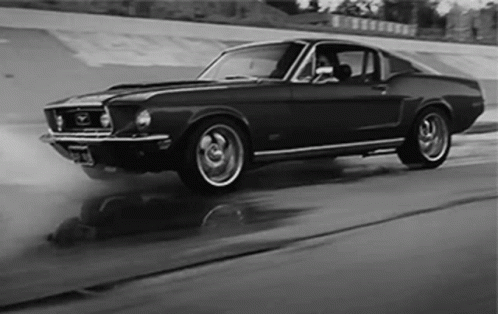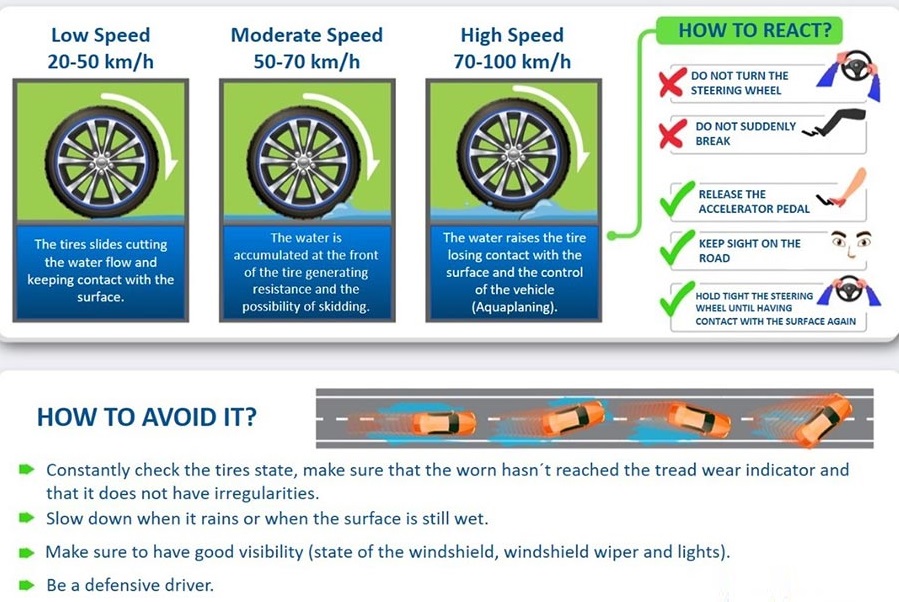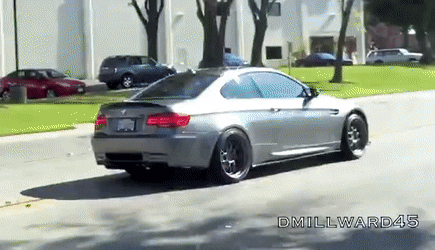
Slow down when there is a lot of water on the road. In a heavy rain at speeds of 50 mph or more, your tires can lose all contact with the road and then your vehicle will be riding on water or “hydroplaning.” A slight change of direction, applying the brakes, or a gust of wind could throw your vehicle into a skid.
Although hydroplaning can occur on any wet surface, the first 30 minutes of rain is often the most dangerous. If you see a big puddle that you are about to drive through, slow by taking your foot off of the accelerator, don’t brake while in a giant puddle.
When the wheels of the vehicle ride on top of the water it causes the tires to separate from the pavement, resulting in a loss of traction. It can occur when driving at the posted speed in bad weather or just after bad weather.. As a safety measure, you should reduce your speed to a safe speed in rainy conditions, allowing the wheels to maintain contact with the road. Remember that speed signs are meant for speeds in best conditions.
Have you ever wondered why in California, even after a light rain and cars have spun out on the side of the freeway? It is because they were going too fast for conditions because the driver thought they needed to drive the maximum posted speed, in the rain. Prevent hydroplaning by driving slower when it is wet and keeping a firm grip with two hands on the wheel.
Ways to Avoid Hydroplaning:
- Make sure your tires are in good condition and have plenty of life in them. You might consider all-weather tires rather than summer tires so the tire tread pattern better handles water.
- When it has been raining and water is on the road, always keep two hands firmly on the wheel. If you run over a puddle of any size keep your wheel straight and let off of the gas while going over the puddle.
- Don’t slam your brakes or stear aggressively while traversing water. If you have enough momentum then just ride over the puddle going straight if possible. You can add gas if needed.


RECOVERING FROM FISH-TAILING
Fishtailing is when the rear end of your car sways back and forth, from side to side. This can occur in conditions such as black ice, water, and/or snow because they reduce traction on the roadway, which can cause the rear wheels of a vehicle to slide out of control. The risk of fishtailing increases at high speeds if a driver approaches a curve poorly or when a driver brakes very suddenly.
To recover from fishtailing, it is important to know what type of brake system your vehicle is equipped with.
If your vehicle begins to skid and your vehicle:
- Has all four-wheel ABS – keep your foot firmly on the brake and steer normally until the car comes to a stop.
- Has just rear-wheel ABS (common in light trucks) – ease up on the brake pedal with just enough pressure to allow the front wheels to roll again so that you can steer.
- Does not have ABS – lightly and briefly “pump” the brakes.
- Has rear-wheel drive – stop braking and turn the steering wheel into the direction of the skid.
- Has front-wheel drive – steer where you want to go and carefully accelerate to keep the vehicle moving.
To pump the brakes, you should push the brake pedal hard. As the vehicle begins to skid, quickly let up on the brake. Push the break down again quickly. Use this quick, pumping action until the vehicle is stopped. To determine if a vehicle has ABS, review your owner’s manual. There may also be an illuminated ABS symbol on your dashboard immediately after starting the engine.
If there has been freezing weather, drive slower than usual and keep both hands on the wheel to give you the best chance of recovering from an unexpected event without losing control and ending up stuck on the side of the road.

RETURNING TO ROAD FROM UNEVEN SURFACE
When the tires on one side of the vehicle drop off the pavement, it can be very dangerous. Dropping off the road due to an uneven surface means the difference in traction between the road surface and the shoulder surface.
Such changes in the road surface can lead to a rollover crash, in which the chance of injury is very high. This can also include road construction work where a temporary surface is in place, or the street has been “milled” in places, taking away some of the surfaces for future surfacing work.
If your vehicle should begin to go off of the roadway and onto an uneven surface such as loose gravel you should first stabilize the vehicle. Maintain a firm grip on the steering wheel and take your foot off of the accelerator. The vehicle may have a tendency to pull towards the shoulder, so be prepared to counter-steer by holding with both hands firmly onto the steering wheel.
Resist the urge to brake hard or to steer sharply back onto the pavement. Each of these actions may cause the vehicle to lose control. You should also slow your speed so that you do not lose control and cross the road into opposing traffic, causing a possible collision. You can lessen your speed by taking your foot off of the accelerator. Do not jam your foot onto the break as your car could swerve and lose control; be gentle with your actions.
Once the vehicle has slowed to a safe speed (25 miles per hour or less), make sure there is a gap in traffic and steer back towards the pavement by turning the steering wheel approximately one-quarter turn. As soon as the outside front tire is back on the road, turn the steering quickly to the right to stay in the correct line. Make any steering adjustments needed.
Steps to Remember:
- Hold the steering wheel firmly and ease off the accelerator.
- With your car straddling the pavement edge, turn your steering wheel up to ¼ turn to the left until the front tire contacts the pavement edge.
- Then turn the steering wheel to go straight down the road. If the level of the shoulder is only slightly below the pavement, recovery is pretty easy. Both right tires should climb over the edge with no problem.
- Recovery is harder if the shoulder is several inches below the pavement level. Try to follow the same procedure above, but if the right front tire “scrubs” against the pavement edge, DON’T steer more sharply to the left. (If you do, your car may jump back onto the road and cross over into the path of another vehicle!) INSTEAD, ease off the accelerator, straighten out your steering, straddle the pavement edge once more, and try again.
